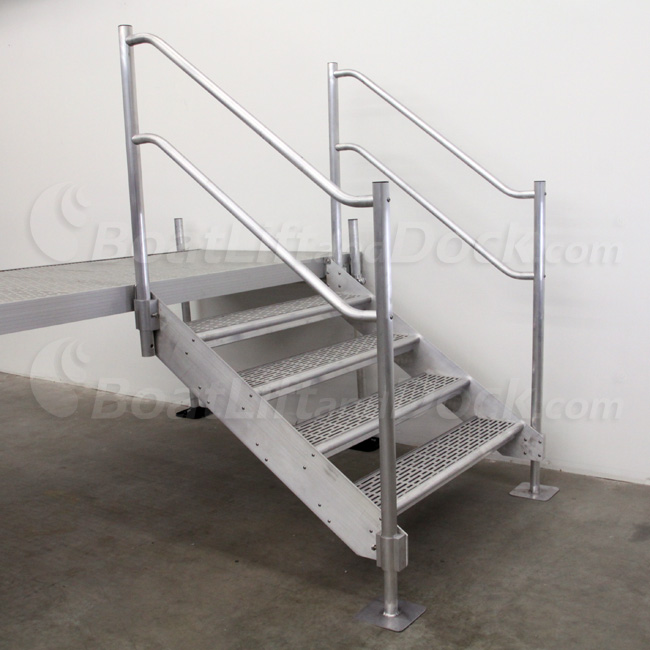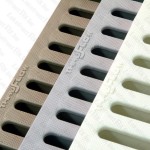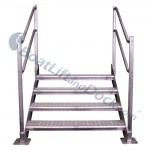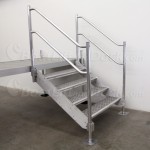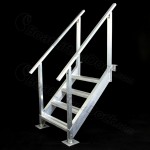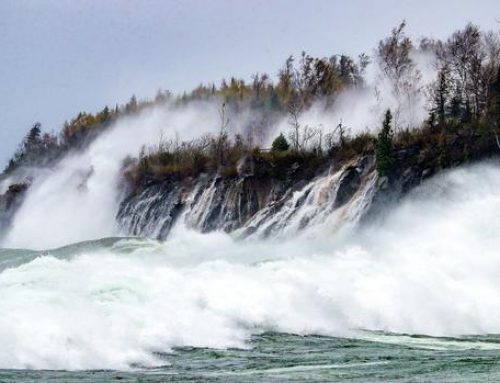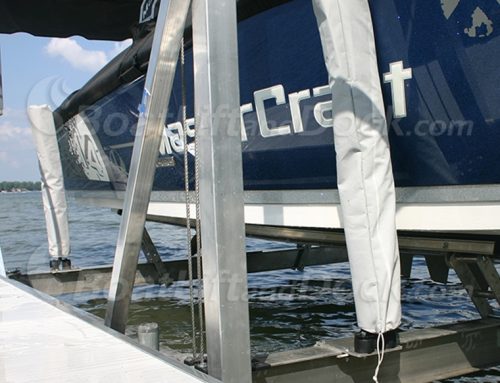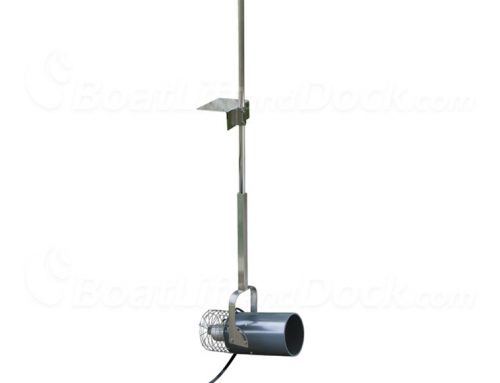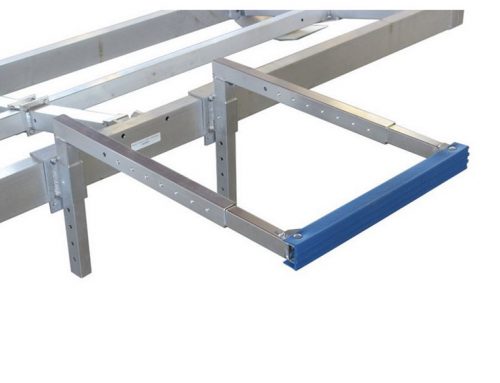Getting in and out of your waterway and back onto your dock or shore is a necessary part of your boating lifestyle. Even if you do not own a boat or Jet Ski and use your waterfront for swimming only, getting into and out of the water should be a safe and easy experience. If you have decided to purchase a dock step system instead of building a wooden step then deciding on what style and size to get will require some information. Some of this information will require you, the customer, to go down to your waterfront and make some observations and take some measurements; the other information you will find here.
To begin, you should take account of the water depths where the dock step will be installed as well as the type of lake or river bed you have. The dock step systems require a solid or semi-solid surface to rest on, as any sinking of the step supports will make the steps uneven and add stress where the steps connect to your dock.
Further, you should consider the amount of traffic that the steps will accommodate. This will determine your tread width; running from just under two feet to up to four feet wide. You should also consider if you want an all aluminum dock step or if you would like your tread to be constructed from another material. There are materials such as Thru Flow™, which is a molded plastic reinforced with fiberglass, that offer, greater comfort to bare feet and free passage of water and air through the tread, giving you a safer step overall.
The distance from the lake bottom to the top of your dock surface or “span” is a major factor to consider as this will determine how many steps you will need the system to have; getting you down safely into the water from your current dock or shoreline. Once you know the span, you can then determine the number of steps you will need by dividing that distance in feet by the rise in the tread of the stair system you are interested in. For example, if you decide on a stair system from MaxStep™, which has a 7” step rise, you would divide the span, say 48”, by 7, giving you the number of steps you will require; in this example 6.8” or 7.
Once you have the final number of steps there is still one more “step” to take; subtract 1. The deck surface of your dock or shoreline doubles as the top step of your stair system, so whatever number you ended up with by dividing your span by the tread rise of the stair system you are interested in, subtract one tread rise distance, in the example above 7”. This number is the number of steps you need in your dock step application, in our example, the final number of steps required would be 6.
If the area in which you will be installing your steps is deep and will require a dock step system with six or more steps you will need to include additional support framework such as extension legs to ensure the stability of the span. Below we will discuss a few dock step options and will outline the benefits and limitations of each.
The MaxStep™ 3′ and 4′ Wide Aluminum Dock Step
This system from MaxStep™ is considered one of the best looking dock steps on the market. It features:
- The three or four foot wide stair width gives this system from MaxStep™ stability and versatility.
- Enough width for two-way traffic or ample one-way traffic to and from your water, dock, seawall, or boardwalk.
- Solid aluminum construction and versatile connection bracket system that allows these steps to be used in multiple applications, both in and out of the water.
- Single or dual handrail options as well as extension legs for deep water applications.
- 2- 12 step options
- The capacity to combine stair units for increased “reach” through the use of extension legs and handrails.
The MaxStep™ system can be used on land to construct a very nice stairway for steep inclines on your property as well; giving this system a versatility lacking in other dock step systems. If you are using this system in deep water, the extension legs and X-brace are required, taking the weight off of the connection point that secures the stairs to your dock or sea wall and adding additional support and stability.
Step versions of 7 or more steps do come standard with dual handrails, whereas the 4 and 6 step options come standard with a single handrail. The stairs themselves are a highly versatile combination of rounded aluminum extrusions and Thru Flow™ grated decking. This combination provides addition 360 degree slip resistance and anti-algae, bare foot friendly features, ensuring a long lasting, attractive, and safe dock step that will last for years. The handrail system come with upper and lower rails, giving all ages the needed assistance into and out of the water.
Shoreline™/Shore Master™ four and six step stair system
Shoreline’s step system is comparable to the MaxStep™ discussed above, but it is designed to attach to your dock, pier, or seawall, and not designed with the option to extend its reach by attaching multiple stairs together. The steps are considered a rigid, fixed system, which is designed to function within specific applications; accommodating deeper water conditions with the inclusion of extension legs. This step system features:
- An all marine aluminum alloy construction style, including the steps themselves
- Stainless steel and brass fasteners.
- Heavy duty, square extrusions with rounded edges, which give the steps strength and an ease of construction that will add comfort and functionality to you waterfront.
- Four or six step options and has a 22” step width with a 6.5” rise; increasing safety with ribbed step surfaces and dual handrails.
Determining the number of steps that you require is done in much the same way as the MaxStep™ system; dividing the span by the rise (6.5”) of the step. The Shoreline™ step
- Functions best where the span or distance from the lake bottom to the top of the dock is 30” to 36” for the 4 step option, and 45” to 50” for the 6 step option.
- Comes with adjustable 16” legs, however, if used in deeper water with extension legs, you should keep in mind that the deeper the water is the greater the final step will be.
- Will attach with a 90 degree, pre-drilled bracket to most stationary and wheel-in docks with flush sides.
- Can be employed in on-shore applications, yet again is not easily modified to work in situations where the span is extensive.
- Will function well in situations where four or six steps will get the job done but is not designed to be combined with another step to reach further.
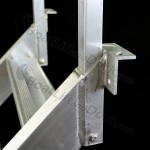
These systems from MaxStep™ and Shoreline™ are only two of the many waterfront step systems on the market and choosing the proper system for your specific application can be difficult. At bottom the information you require to get the right system is the depth of your water, your lake or river bottom conditions and the type of connection you need to make at your dock or seawall.
If you are intending to use any of these systems on land then your considerations become a bit simpler; take a measurement of the span to be covered and choose a step that will do the job. On the other hand, if you need to get down from a dock or seawall, then you need to consider the stability and safety of the dock step and having some of the basic information is essential.
© 2013 BoatLiftandDock.com

